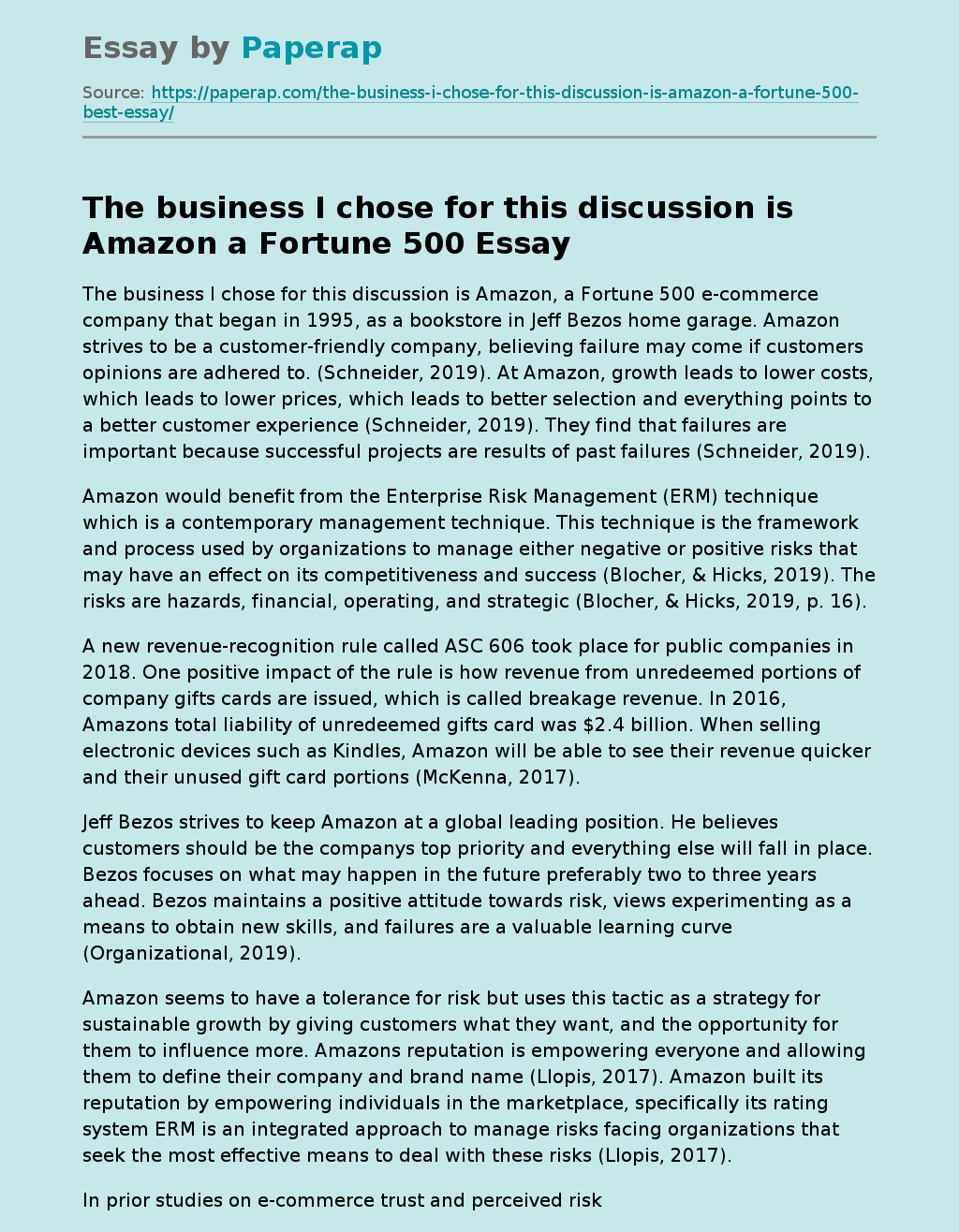The business I chose for this discussion is Amazon a Fortune 500
The business I chose for this discussion is Amazon, a Fortune 500 e-commerce company that began in 1995, as a bookstore in Jeff Bezos home garage. Amazon strives to be a customer-friendly company, believing failure may come if customers opinions are adhered to. (Schneider, 2019). At Amazon, growth leads to lower costs, which leads to lower prices, which leads to better selection and everything points to a better customer experience (Schneider, 2019). They find that failures are important because successful projects are results of past failures (Schneider, 2019).
Amazon would benefit from the Enterprise Risk Management (ERM) technique which is a contemporary management technique. This technique is the framework and process used by organizations to manage either negative or positive risks that may have an effect on its competitiveness and success (Blocher, & Hicks, 2019). The risks are hazards, financial, operating, and strategic (Blocher, & Hicks, 2019, p. 16).
A new revenue-recognition rule called ASC 606 took place for public companies in 2018. One positive impact of the rule is how revenue from unredeemed portions of company gifts cards are issued, which is called breakage revenue.
In 2016, Amazons total liability of unredeemed gifts card was $2.4 billion. When selling electronic devices such as Kindles, Amazon will be able to see their revenue quicker and their unused gift card portions (McKenna, 2017).
Jeff Bezos strives to keep Amazon at a global leading position. He believes customers should be the companys top priority and everything else will fall in place. Bezos focuses on what may happen in the future preferably two to three years ahead.
Bezos maintains a positive attitude towards risk, views experimenting as a means to obtain new skills, and failures are a valuable learning curve (Organizational, 2019).
Amazon seems to have a tolerance for risk but uses this tactic as a strategy for sustainable growth by giving customers what they want, and the opportunity for them to influence more. Amazons reputation is empowering everyone and allowing them to define their company and brand name (Llopis, 2017). Amazon built its reputation by empowering individuals in the marketplace, specifically its rating system ERM is an integrated approach to manage risks facing organizations that seek the most effective means to deal with these risks (Llopis, 2017).
In prior studies on e-commerce trust and perceived risk are the main components of online transaction behavior (Pavlou, 2003). Trust is the main reason for successful online transactions and the development of buyer?seller relationships in e?commerce because online transactions feature high uncertainty and risks that may occur from the information imbalance between buyers and sellers (Chiu, Wang, Fang, & Huang, 2012). Perceived risk refers to the belief that transaction partys loss could occur because of the opportunistic behavior of another party (Pavlou & Gefen, 2004). It is more challenging to manage international delivery logistics because sellers may face higher risk from transactions and uncertainty of payment in cross?border e?commerce (Guo, Bao, Stuart, & Le-Nguyen, 2018, p. 366).
The business I chose for this discussion is Amazon a Fortune 500. (2019, Dec 12). Retrieved from https://paperap.com/the-business-i-chose-for-this-discussion-is-amazon-a-fortune-500-best-essay/

